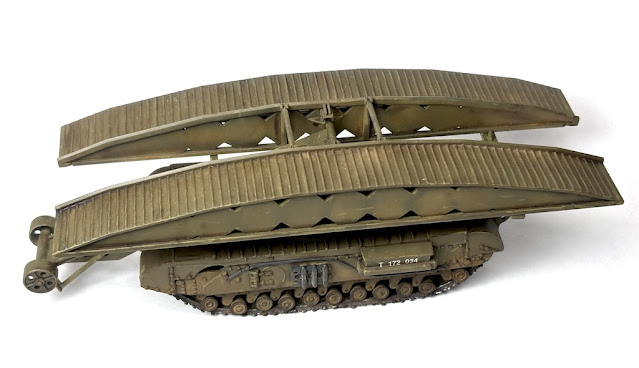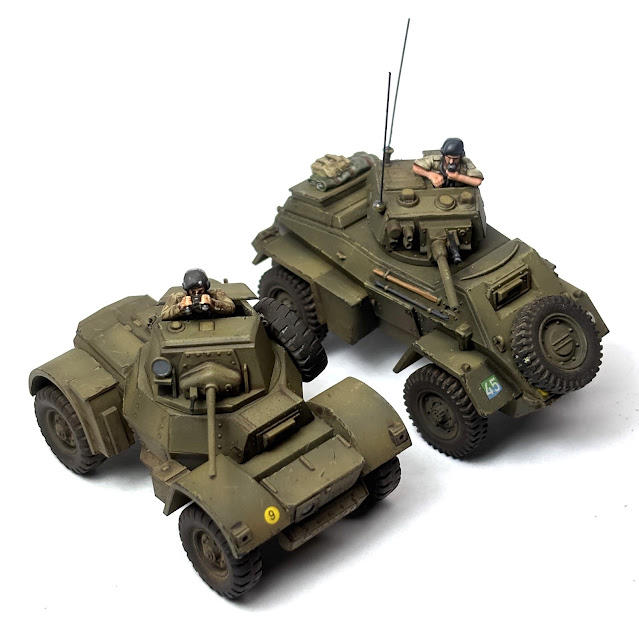Something of a British theme happening at the moment on the AFV front. I'm filling various gaps in the collection and in the process working my way through a lot of green paint.
I started making Airfix models a very long time ago and it seems I'm still doing it. I was given their Churchill Bridgelayer as a gift one Christmas. It wasn't something I could see an immediate need for, in fact, I wasn't sure if a time would ever come when I would use it in a game. Despite that, I always intended to make it. The kit is basically the old Airfix Churchill, but comes with additional sprues to omit the turret and convert it into the bridgelayer.
It's possible to make it without permanently attaching the bridge component, so I've deliberately left that so I can remove it. There's probably more chance of the bridge appearing on a game table than the whole bridgelayer itself, but, you never know.
As it has always been, the road wheels are a fiddly and troublesome part of the kit. Although I did discover several years ago that the wheels are spaced exactly on the sprue to match the chassis, so it's possible to glue those parts before removing the wheels from the sprue. I wish I'd known that when I was ten years old.
I picked up the old kit of the Hasegawa Daimler armoured car. It's not quite the same vintage as the Airfix Churchill, but it's not too far off. The kit looked very basic when I opened the box, but it actually builds into a very presentable little version of the armoured car. All I've added is a crew figure from one of the Plastic Soldier Company sets.
If the Hasegawa model is of 1970s vintage, then this PSC model of the Humber is 50 years its junior.
This one I've marked for an Indian armoured brigade in Burma to run with the recent batch of Sherman Vs that I painted.
Despite the age difference between the two armoured car kits, I think the old Hasegawa model holds its own.
Playing a platoon level skirmish game like Chain of Command means heavy artillery pieces have no place on the table top. If they do, they are more often than not an objective. However, when I came across images of a 5.5" gun firing over open sights at the walls of Fort Dufferin in Mandalay, I had second thoughts. Perhaps there could be a role for such a heavy artillery piece?
Further investigation revealed that wasn't the only time those guns were used in this way. I know of two other cases, both during the second Arakan campaign, where they were brought forward and used in bunker-busting roles. Naturally that led to me to consider another venerable old Airfix kit - the 5.5" and Matador. Coincidentally, recently re-released as part of their Vintage Classic range. No need to guess what happened next.

This one also brings back many memories and the kit holds up a lot better than I expected, given its age. While I may use the gun for scenarios set in Burma, I simply used the decals that come with the kit for the Matador, which I believe, are marked for a unit serving in Italy.
The gun will need a suitable crew. AB Figures do a lovely set for a European setting and currently their only crew for a weapon in Burma is a set for a 3" mortar. Lovely as those figures are, their poses are quite specific to their weapon. One option would be to mix up both sets, as the figures for Europe are mainly working in shirt sleeves and could be passed off for the Far East. That's a project for another day.
So, what with Airfix and Hasegawa, you'd think we were living in the 1970s! Although it would be fair to admit, the me of all those years ago wasn't anywhere near this good at painting. I'd like to think he'd be very happy to know what he might one day achieve.
If Airfix and Hasegawa were state of the art for their day then Vespid, a relatively new entrant to the 1/72 plastic kit world, brings us right up to the 21st century. This is their Comet Ia, an absolutely beautiful kit, that went together like a dream.
It's definitely a modeller's kit, complete with photo etched detail, but it looks the part. A couple of AB crew figures set it off nicely.
That now gives me three distinctively British tanks for the late war. The British designed and built Cromwell and Comet, as well as the Sherman Firefly variant with the 17 pounder gun.
I think with the Cromwell and then the Comet, you can start to the see the design evolution that would lead to the Centurion tank.
I've gone a bit overboard with aircraft lately, but I've been enjoying making something different and found companies like Academy, Hobby Boss and Airfix produce affordable kits that are quick to build. I've been looking for a Vultee Vengeance for Burma, but unfortunately, a reasonably priced model has been hard to find, so instead, I've opted for a P47 Thunderbolt. The RAF chose to use these only in Burma, where they performed a very useful ground support role. This is the Academy kit.
I was sorting through a small stash of half completed aircraft kits that I had started making several years ago and came across a built, but unpainted, Airfix Hurricane IIc. I have one from Hobby Boss that I painted for use as a marker for Hurribomber attacks, but was never happy with the paint scheme I'd used. As I had a set of Hurricane decals for Burma it was an easy decision to paint it while doing the Thunderbolt.
As is often the case, I have no immediate plans to use any of these in forthcoming games. I think it's driven by two things. One, is the completist in me, I like to think if I need it one day, I have it ready and waiting. Second, it's what's driven me along ever since my very first Airfix kits, I like making models. Always have.























Superb work there Mark!
ReplyDeleteThanks!
DeleteThose are wonderful additions and perfectly painted.
ReplyDeleteThank you!
DeleteLovely work, they all look really top notch.
ReplyDeleteThanks!
DeleteAll looking splendid as ever, particularly jealous of the Jug. I've just finished my campaign so will take break (do other rules / periods) before the next one - hoping the second edition might finally appear for Salute this year.
ReplyDeleteThing’s definitely moving along with v2 from what I’m hearing but no final publication date set just yet. We have another Dux game this week but then winter sets in (in campaign terms) so we might take a break and start up our next CoC campaign.
DeleteAll very nice, I do like the paint scheme and weathering.
ReplyDeleteAnother problem with the Airfix Churchill is that the pins that go into the holes for the wheels are too short. You can overcome this by sticking a strip of plastic card on the inside of the inner set of holes and drilling through. Probanly completely useless information to you now!
Probably more work than this old kit deserves. When I was at the Imperial War Museum last year I noticed they were selling the Churchill kit in the gift shop. My heart sank as I thought, if this was someone’s first experience of modelling, it would be enough to put them off for life. How we persisted with it back in the day, I will never know.
DeleteSmart! I wish I'd known that trick for the Churchill wheels. Oh, the fun I had trying to fit those little buggers!
ReplyDeleteIt seems that it was a traumatic build for everyone who ever attempted it. Somehow we all survived the experience!
DeleteMy last attempt about 10 years ago required a workbench , clamps and large amounts of super glue poured into every gap. I still shudder but it came out alright. After that I bought resin or Matchbox/Revell ones. Can’t afford them now as the Revell ones are £25 each!
ReplyDeleteIt really does make me wonder how my friends and I ever persevered all those years ago, when the only tools we had were a cheap craft knife and a tube of polystyrene glue.
DeleteGreat work, thanks for sharing. The mismatched tyres on the 5.5 in the photo are interesting as well as what looks like a webbing belt for a revolver on the gunner with the helmet.
ReplyDeleteWell spotted, I missed those completely (although now I can see them, I can’t help but notice). If you did that on a model you’d have a whole timeline filled with comments from people telling you that you’ve mismatched the tyres and the model is ‘wrong’.
Delete